The 27-inch Apple iMac Review (2011)
by Anand Lal Shimpi on May 27, 2011 2:30 AM ESTPower, Thermals and Noise
I started this review complaining about how loud the 15-inch MacBook Pro gets, but with 32x the physical volume the 27-inch iMac is near silent. Even under load the system is very quiet, almost too quiet. Apple chose a very lax fan profile which results in some very high external temperatures. The iMac takes in cool air from the bottom of the display and exhausts it up top behind the display. Playing Half Life 2 Episode Two I measured a maximum surface temperature of 125F at the exhaust vent. Again, unless you're doing something weird with the iMac on your lap this isn't an issue. Keep in mind that the Sandy Bridge CPU in the 15-inch MacBook Pro carries a 45W TDP and what's in the iMac is either 65W or 95W. Add in a larger, hotter hard drive and potentially a beefier GPU and you have a recipe for a pretty warm machine.
| 2011 iMac Power Usage | ||||||
| 27-inch iMac (Mid 2011) | Idle | Cinebench R11.5 | Half Life 2 Episode Two | |||
| Minimum Brightness | 54.1W | 108.3W | 149.0W | |||
| 50% Brightness | 86.6W | 141.6W | 180.0W | |||
| 100% Brightness | 144.5W | 198.3W | 240.0W | |||
With a large integrated display power consumption obviously varies depending on brightness. At idle, power consumption ranges from 54W to 144W. Under load the range quickly gets ever higher. I measured max system power consumption at 240W running Half Life 2 Episode Two.
Power consumption isn't out of control but you've got a billion transistor CPU, a 1.7B transistor GPU and a high resolution 27-inch display + backlight - it's going to draw some power.
Performance
Having never previously been a fan of the iMac, I don't actually have any historical performance data to compare to. What I do have however are scores from Mac Pros and of course the MacBook/MacBook Pro lines from the past couple of years.
Adobe Photoshop CS4 Performance
The Retouch Artists Speed Test we use for our CPU testing under Windows also works under OS X. We're running the exact same benchmark here, basically performing a bunch of image manipulations and filters and timing the entire process.
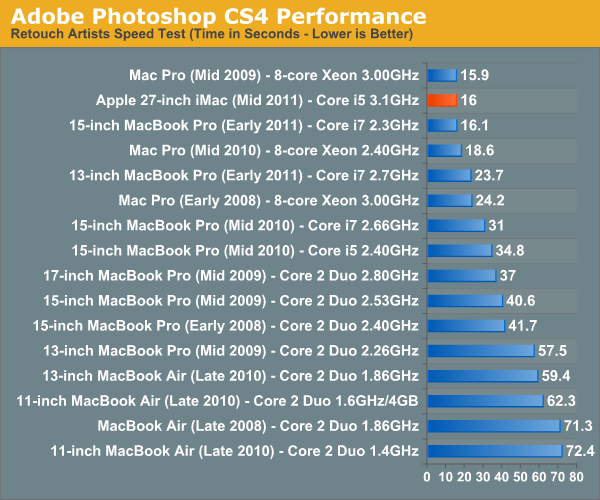
The high-end 27-inch iMac is a very capable Photoshop machine. A hair faster than the new MacBook Pro, the iMac delivers the same performance as an 8-core Mac Pro from 2009 or 2010.
Aperture 2 RAW Import
For my Aperture test I simply timed how long it took to import 203 12MP RAW images into the library.
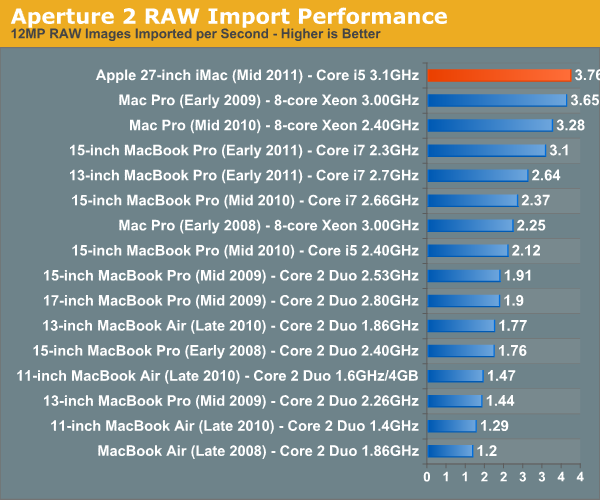
We have a new winner here! The MacBook Pros were always limited by their slower 2.5" hard drive, but the iMac with Sandy Bridge in additional to a speedier disk give us better image import performance than the '09 and '10 Mac Pros. I told you this thing was fast.
Cinebench R10 & 11.5
I’m a fan of the Cinebench tests because they lets me show off both single and multithreaded performance in the same workload. First, the single threaded performance:
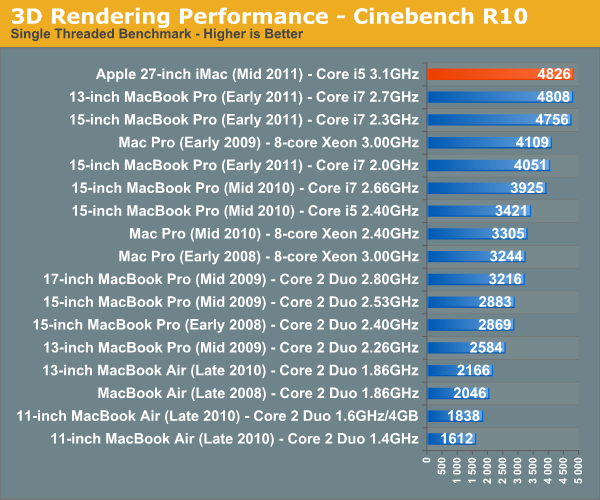
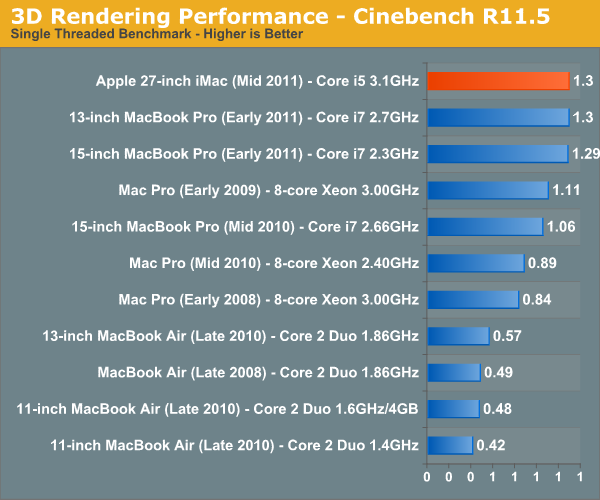
Sandy Bridge quad-core CPUs make no sacrifices. You get excellent single threaded performance which means general OS usage, launching applications and even rendering most web pages happens as fast as physically possible as the other cores are power gated and asleep. Start multitasking however and you'll see the Core i5 in this machine is no slouch:
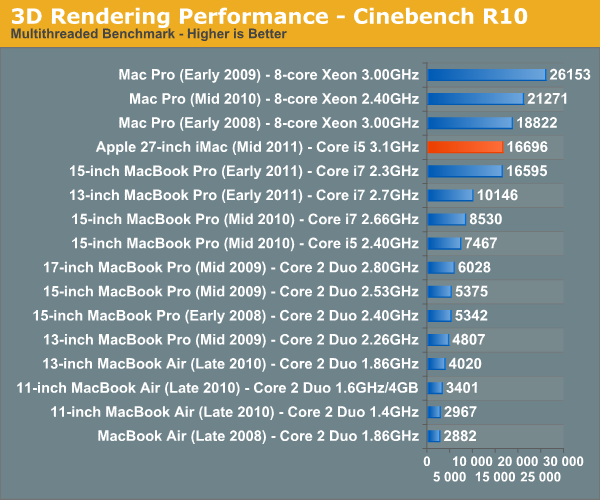
There's still no replacement for more cores when it comes to heavily threaded applications, the past three years of 8-core Mac Pros are still faster than the new 27-inch iMac here. I suspect the upgraded Core i7 would at least let the iMac beat the 2008 Mac Pro thanks to Hyper Threading, but the other two systems are simply out of reach. For those users, you're better off waiting for the Sandy Bridge-E Mac Pro update expected sometime in Q4.
You'll notice in Cinebench R10 the 15-inch MacBook Pro is nipping at the heels of the new iMac. Chalk that up to the larger L3 cache and Hyper Threading, both advantages enjoyed by the MacBook Pro. Look at what those advantages do in Cinebench R11.5's multithreaded test:
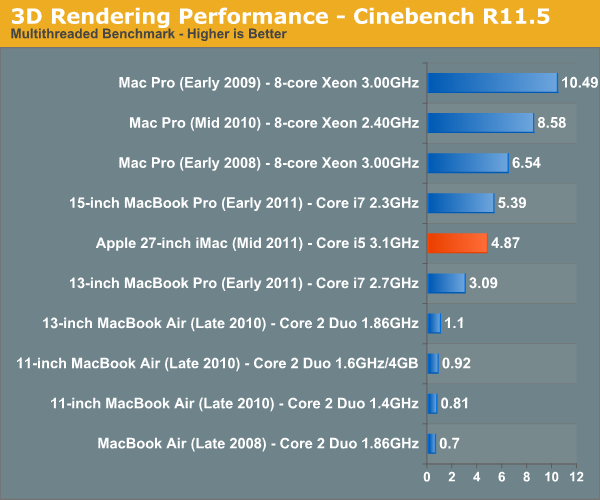
Here the MacBook Pro actually gains on the iMac. More threads and more cache are better suited for the Cinebench workload. If you do a lot of offline 3D rendering and you want the iMac, I'd suggest upgrading to the Core i7-2600 that Apple offers. You get a not insignificant boost in clock speed but more importantly, Intel switches on Hyper Threading which gives you twice as many threads.
Quicktime H.264 Video Encoding
Our final benchmark is more consumer focused. Here I'm taking an XviD and converting it to an iPhone-supported H.264 format.

QuickTime doesn't make tremendous use of all cores all of the time, and thus the MacBook Pro loses its threading advantage. The iMac is our new champion of this test.










139 Comments
View All Comments
stm1185 - Friday, May 27, 2011 - link
So basically to get rid of having a tower, which probably can take up floor space you don't use anyway, you get about $700 worth of desktop hardware and a $1000 monitor rolled into one at the price of $2000. Which does not seem that bad of a deal, except I could never see myself having a monitor that costs more then the computer used with it. It seems very backwards.For instance is the experience with having 2560x1440 resolution over 1920x1080 better then the experience that you get with $1600 worth of hardware over $700? I think I would say No.
MrBigglesw0rth - Friday, May 27, 2011 - link
Did you stop to consider what youre going to get for that 900$ more hardware cost? The main thing would be an SSD, then double the RAM. After that, what? Better speakers? Another optical drive? Expensive headsets? Maybe $300+ for 15% better processing power? How about a new paintjob on your car?Dont be silly. The best investment would be something you look at constantly; the display. When youre looking at minimal computational gains over a vastly better viewing experience for 2-3 new computer builds to come.
Also, this isnt 1995 anymore. You can get 80% of the power for 20% of the cost. The largest cost in a good system today is a quality SSD and a quality screen, followed by the CPU, mobo/ram, etc.
aguilpa1 - Friday, May 27, 2011 - link
Fine a display is important and that is why I have 3 of them at 5760x1080, 120Hz Alienware Optx23's but ONLY if the displays are independent of the system, meaning not built in whereby the computer becomes obsolete and then what??? How are you going to upgrade the motherboard on a proprietary and overpriced all in one? Proprietary junk will never be of great value no matter how pretty they are. It's been tried again and again.Keeping your old monitor that is still good to save money makes sense but not on an all in one unit. It never has and never will.
harshbarj - Friday, May 27, 2011 - link
That is a good point! I have been running the same lcd now for 7 years and this is the 5th desktop to use this monitor. It was the first high end gaming 19 inch lcd on the market when I got it and even today it still looks great. Had I gone the imac way (which I would never as I play games) and bought an all in one, I would have needed to buy a new monitor with each new system.headbox - Friday, May 27, 2011 - link
whatever. You can get a 23" widescreen display for barely over $100 now. You're just not in the crowd of people that can afford upgrades. All of these price criticisms always come from people that Apple doesn't market towards anyways: broke nerds. For MANY people, $2000 is not a big deal for a computer every 2 years (or less.)harshbarj - Friday, May 27, 2011 - link
Really? Best price on newegg is about $150 and that monitor is noticeably smaller in height than my 19 inch. Anyway why replace something that still works just fine? Seems kind of stupid to me!Also for MOST people $2000 is a big deal.
samirotiv - Saturday, May 28, 2011 - link
buddy, this is a 27 inch LED backlit IPS display. What you're talking about is a TN display.samirotiv - Saturday, May 28, 2011 - link
Don't get me wrong, I do agree with you. 2000USD is an investment. Some people have very basic performance needs, and can live with the same machine for 5 years. They value a good display, way more than a fast CPU. They attribute almost no importance to a GPU. A Mac takes almost no space, has almost no cables, no clutter. Some people value that.Besides, macs have a decent resale value too. But if I wanted a machine for myself, I wouldn't take a mac. I'd go for a custom built one.
utlragear - Monday, June 11, 2012 - link
Well it's not like blowing $2000 for an imac will get you major performance anyway. Apple only ships mdgrade hardware and it's always been that way. They pocket an extra $1000 off each isucker, and that can be PROVEN and broken down in itemized price lists. If one must, just build a PC for $700 that runs rings around an imac. Then hackintosh it and it will be faster than the one apple ships for $2000 by far. PROOF that they do exactly what I'm saying they do. But I can't see any reason to run an OS that is no better than win 7. If you want someone that has almost no cables get an ALL IN ONE PC. They are not like that because they are Macs. Macs are simply PC's anyway. There is NO value in it simply being apple. That statement will make some people mad, but sometimes when you break up someone's fantasies they also get mad.KoolAidMan1 - Sunday, May 29, 2011 - link
A 27" 2560x1440 IPS display with LED backlighting is going to cost a lot more than a 23" 1080p LCD with a TN panel.Shocking.